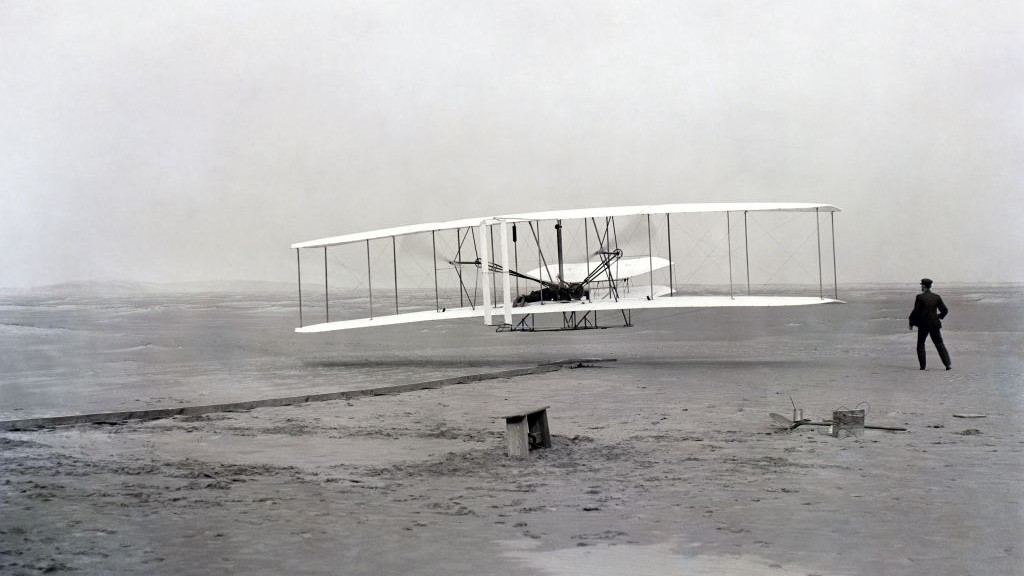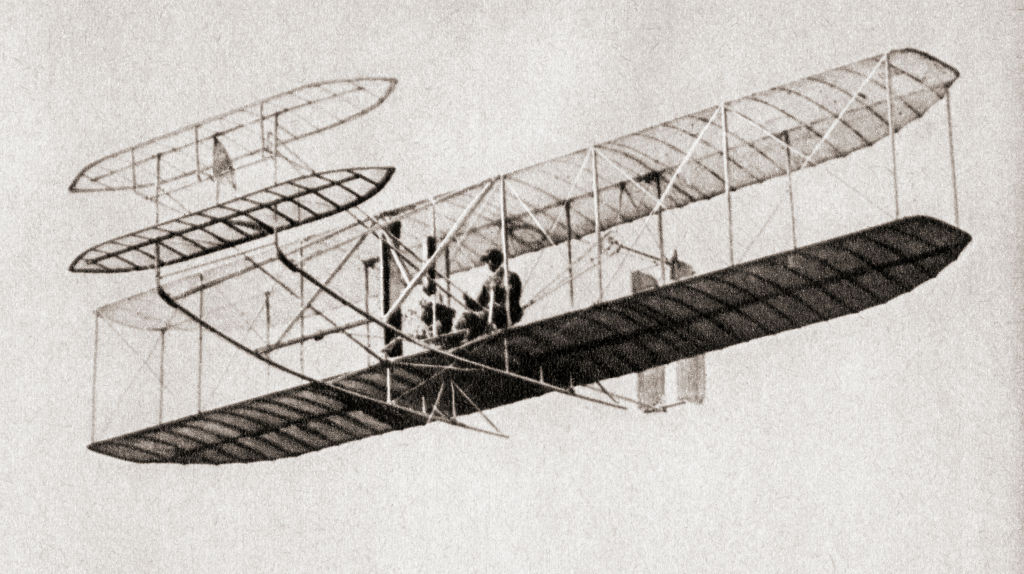The Wright brothers and the first airplane flight
The Wright brothers made history with the successful flight of their Wright Flyer in 1903.

The Wright brothers' first airplane flight on Dec. 17, 1903, lasted only 12 seconds, and news of the achievement appeared in just four newspapers the next morning. However, the groundbreaking 120-foot (37-meter) flight in a fragile aircraft over Kitty Hawk, North Carolina, would go on to have a profound impact on the world.
Brothers Orville and Wilbur Wright did not invent flight, but their craftsmanship skills helped them form the early 20th-century equivalent of a startup. Their invention of the Flyer, which was the first crewed, powered, heavier-than-air and (to some degree) controlled-flight aircraft, brought people and ideas together like never before. In just a few decades, their ideas led to the creation of new aircraft in warfare, assisted with the spread of goods and people for globalization, and led to spaceflight — including putting the first people on the moon, in 1969.
Humble beginnings
Interest in aeronautics exploded during the 19th century, as the technical how-to finally caught up with humanity's centuries-old interest in flight. Before airplanes, people flew in balloons, airships and gliders — but never in something heavier than air. Several scientists tested gliders throughout the 1800s, filling data tables with information about lift and drag, but no gliders ran on power other than that provided by the wind. A steam-powered airship built by Henri Giffard flew successfully in 1852.
Step 1 for the Wright brothers was to do a literature search on the state of aeronautical knowledge at the time. In 1899, Wilbur wrote this letter to the Smithsonian Institution, requesting copies of all the past research done:
"Dear Sirs:
I am an enthusiast, but not a crank in the sense that I have some pet theories as to the proper construction of a flying machine. I wish to avail myself of all that is already known and then if possible add my might to help on the future worker who will attain final success."
The brothers studied the hang-gliding flights of Otto Lilienthal and work done by Sir Georg Cayley, the founder of aerodynamics. The Wrights picked the brain of Octave Chanute, an engineer who had worked to invent an airplane and the author of the book "Progress in Flying Machines" (Dover Publications, 1894).
With the profits earned at their bike store, Wilbur (the visionary) and Orville (the engineer) set to work on a flying machine. The brothers started by building kites based on the flight mechanics of birds they had observed, then moved on to manned gliders.
The first flight
Four years after Wilbur's humble letter, the Wrights were ready to test an aircraft powered by an engine and propeller. The biplane design was based on Chanute's biplane glider, and the engine was assembled by Charles Taylor, a mechanic in the Wright's bike shop.
On Dec. 17, 1903, Orville climbed into the primitive cockpit. The Flyer lifted from the level ground of Kitty Hawk into the air and flew for 12 seconds before landing with a thud 120 feet (37 m) away. Kitty Hawk was chosen for its consistent winds, which were good for testing kites and gliders and also for taking off with an underpowered airplane. While strong wind gusts could be dangerous, a good, consistent headwind allowed a plane to take off when its own power might not get it off the ground in windless conditions.
The brothers made four flights that day, the last one flying 852 feet (260 m) in distance and staying aloft for almost a minute, launching the world into the aviation age for good.

From Kitty Hawk to outer space
When news of their accomplishment at Kitty Hawk hit the news wires, rival inventors began testing their own flying machines in fields and open spaces around the world.
It was the U.S. government that encouraged the first mass manufacturing of the airplane, seeing the potential of a powerful weapon and reconnaissance vehicle. When World War I broke out in 1914, there was a new type of battlefield: the sky. Airplane technology sped up dramatically during the war and was a pillar of the wartime economy.
By the 1930s, the U.S. had four airlines delivering millions of passengers (limited mostly to the upper class) to points across the country, across the Atlantic Ocean and, by the end of the decade, across the Pacific. With the dawn of commercial air service, the world opened up in a new way, allowing people to visit places they'd only read about in books.
Aviation greatly affected the outcome of World War II, too, and war equally affected aviation. Airplanes carried paratroopers across the English Channel and dropped the first atomic bomb. By the end of the war, the manufacturing of planes had helped to put the United States at the forefront of all the world's postwar economies, where it remained until the 1970s.
The birth of the jet age in the 1950s, American astronauts' first steps on the moon between 1969 and 1972, and even the dreams of space-tourist companies like Virgin Galactic and the self-landing rockets of SpaceX all have their scientific roots in the field of Kitty Hawk.
A Wright Flyer is on display at the Smithsonian National Air and Space Museum in Washington, D.C. In 2003, a replica Wright Flyer attempted the same flight at Kitty Hawk on the 100th anniversary of the Wrights' achievement, but it fell into a mud puddle. Conditions were quite calm that day, and Tom Poberezny, president of the Experimental Aircraft Association, which helped build the replica, told Wired, "Well, if this were easy, I guess everyone would do it."
Another challenge in creating a replica was that the Wright brothers kept the original plans secret, and the famed Wright Flyer was wrecked shortly after its fourth flight, by a gust of wind. While Orville rebuilt the Flyer for display, it's unclear if parts of the Flyer were recycled into other planes, according to the EAA Aviation Museum.
Additional resources
You can learn more about the Wright Flyer in these resources from the National Park Service. Check out the Wright Brothers Collection at Wright State University in Dayton, Ohio. Watch this video about the 1903 Wright Flyer replica at the EAA AirVenture Museum.
Join our Space Forums to keep talking space on the latest missions, night sky and more! And if you have a news tip, correction or comment, let us know at: community@space.com.
Get the Space.com Newsletter
Breaking space news, the latest updates on rocket launches, skywatching events and more!

Elizabeth Howell (she/her), Ph.D., was a staff writer in the spaceflight channel between 2022 and 2024 specializing in Canadian space news. She was contributing writer for Space.com for 10 years from 2012 to 2024. Elizabeth's reporting includes multiple exclusives with the White House, leading world coverage about a lost-and-found space tomato on the International Space Station, witnessing five human spaceflight launches on two continents, flying parabolic, working inside a spacesuit, and participating in a simulated Mars mission. Her latest book, "Why Am I Taller?" (ECW Press, 2022) is co-written with astronaut Dave Williams.











